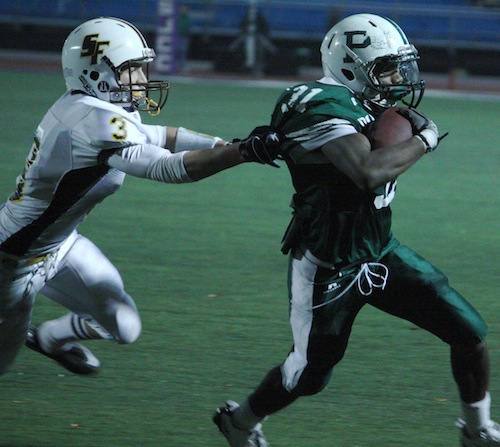Public Schooled: a mantra that has resonated throughout the Paly athletic community for years. However when one ventures outside of the “Palo Alto bubble,” this statement falls flat, listless and generally void of truth.
However that raises the question, why did everyone expect the private schools to inherently trounce the Vikings?
The Vikings had a plethora of players who were scheduled to play D1 football at very competitive schools, such as Stanford, UCLA, and Fresno State. The Vikings proved that a public school could hang with the big boys and despite this, many still expected the private schools to win due to the fact that they were, well, private schools. They could recruit, they had more money, and they could bring in the best athletes through scholarships, thus many thought that the Vikings didn’t stand a chance when they came into the postseason against the WCAL. Yet, the bantam bunch bashed the WCAL and many opinions in Palo Alto and the Bay Area were changed over the true difference between public schools and private schools.
Rankings and hype aside, both private and public schools offer unique and varying experiences to student athletes.
Perhaps the most important differentiating factor between private and public schools is the tuition. For those unfamiliar with private schools, one must pay tuition every year to attend a private school. With tuition as high as $40,000 for some elite private schools, private schools find themselves at an innate advantage financially over public schools.
While at public schools athletics and art are the first things to go when the budget is tight, private schools seldom have any budget issues at all. This surplus of revenue results in a massive portion of a schools yearly income going to athletics.
The extra funds available to these schools allows them to have better paid coaches, larger stadiums, top-of-the-line equipment, more expensive weight rooms and better uniforms. On top of the fact that they have a deluge of extra dough, private schools can also recruit players from out of their area giving them athletic scholarships to come play at their respective schools.
While this may seem like an overwhelming advantage for private schools, many think that the true differences lie in other areas. As assistant lacrosse head coach at Bellarmine, program director of Team NorCal, and executive director of Tomahawks Lacrosse, Matt Skiba has had extensive experience with athletes from both public and private Schools.
“The one interesting factor is the difference in maturity level,” Skiba said. “The kids I’ve encountered from private schools in San Francisco alone seem to be more mature.”
Players and coaches alike harp on the same issues. Being a varsity Lacrosse player at Bellarmine and midfielder for Team NorCal, Henry Armistead (‘14) has had similar experience with players and coaches from public and private schools.
The Bells displayed their true discipline as their maturity and determination permeated into every facet of their play as they overwhelmed the Vikings in the 2011 CCS Open Division Championship. The Bells worked the tired Vikings defense, formerly known as “The Swarm”, up and down the field as they ran up the score, eventually winning by an impressive score of 41-13, putting to rest the Vikes hopes of defending their Open Title.
Earl Hansen, Athletic Director and head coach of the Vikings Football Team, perpetuates similar themes in the success of Paly’s Athletics.
With the emphasis not on winning, but rather on participation, Athletics at Pinewood are based around enjoyment and fun. “There is more room to play what you like,” Peery said.
With tuition at over $25,000, one may think that Pinewood could invest serious money into Athletics; however with such a small student body, at little over 180 students, the vast majority of funds to the classroom rather than the football field. Thus the brash assumption that all private schools rake in mounds of money is simply false.
While we may like to credit the success of Private Schools to their money rather than their coaching and play, the reason for their success is truly a gray area.
“When it comes to athletic ability, I can’t see much of a difference,” Skiba said.Although money does factor into the equation, disciplined coaching and performance on the field makes schools like Bellarmine as good as they are.
On the other hand, schools like Pinewood simply don’t have the money to pour into Athletics and thus have a much weaker team than Paly. Since Paly is a financially privileged town with an elite coaching staff and determined players, Paly remains a perennial powerhouse in CCS.
What it truly comes down to isn’t a presumptuous classification of all Private Schools or all Public Schools being either phenomenal or mediocre athletically, but rather a look at each individual school because they all offer unique opportunities on and off the field.
“While you may like to classify all Private Schools as athletic power houses, the truth is each school offers something unique,” Peery said.
Whether it be Public or Private, cost $40,000 or $4,000, one can’t simply label a school as an athletic powerhouse unless they want to make a presumption as brash and foolish as thinking a Kardashian marriage will last longer than several months.




